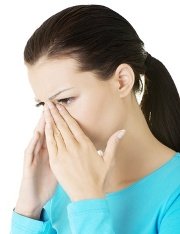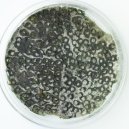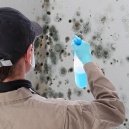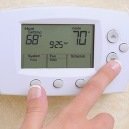Find a pre-screened local mold removal specialist Free Estimate
Find a Mold Specialist Now
Click or Call, Toll-Free 24/7
Symptoms of Mold Exposure
People often mistake the symptoms of mold exposure for other things. They might think they are experiencing seasonal allergies, like hay fever. They might wonder if they are allergic to pet dander. They might think they just have a cold or sinus infection, since mold symptoms resemble those common conditions. Of course, if you realize you have a mold problem in your home, you might suspect your symptoms are related to mold. Many people don’t realize they have a mold problem until they start getting sick, though. That’s because mold often grows in places where it’s hard to spot, like inside walls, inside heating ducts, and under flooring.
Common Symptoms of Mold Exposure
The most common mold symptoms are similar to symptoms of exposure to other environmental allergens, and include things like:
- A runny nose
- Sinus congestion
- Sneezing
- Coughing
- Red, itchy, watery eyes
- Headaches, migraines
- Sore throat
- Shortness of breath
- Wheezing
- Feeling of tightness in the chest
- Asthma attacks. Follow this link to learn more about asthma due to mold
These symptoms may begin within hours of being in a home with mold, depending on how much mold is there and what type of mold is present. Symptoms will usually get worse over time.
Mold can affect your pets as well. Here is more information on pets and mold.
Less Common Mold Symptoms
Less common symptoms of mold exposure include things like:
- Respiratory infections, like pneumonia and bronchitis
- Bleeding in the lungs (pulmonary hemorrhage)
- Scar tissue in the lungs (caused by long-term exposure to mold)
- Digestive problems
- Skin rash or hives
- Joint pain from mycotoxins
- Depression
- Fatigue
- Memory loss
- Difficulty concentrating
- Tingling and numbness in the hands and/or feet
- Dental issues
- Hair loss
- Exercise intolerance
- Hearing loss
- Vertigo (lightheadedness or dizziness)
- Heart damage
These mold poisoning symptoms may take some time to develop. People usually experience other allergy-like symptoms first. Some of these problems, like the buildup of scar tissue in the lungs, can cause life-long problems.
Treating Symptoms of Mold Exposure

If you’re suffering from health problems related to mold exposure, there are two important components of treatment.
First, you need to see your doctor. Let your doctor know if you’ve been exposed to mold and that your symptoms may be related to mold exposure. It may affect the treatment prescribed. Your doctor may prescribe antihistamines or other medications for allergy-like symptoms. If you have infections like bronchitis or pneumonia, you’ll probably need antibiotics. If your symptoms are severe, your doctor may recommend not returning to your home until the mold can be removed.
Second, you need to have all traces of mold removed from your home. As long as you continue to be exposed to mold, you’ll probably continue to suffer from toxic mold symptoms. In fact, the symptoms will probably get worse as time goes on. Any medical treatment will be of limited effectiveness as long as you continue to be around mold.
Mold remediation is a complicated procedure and while some homeowners prefer to handle the job themselves, it’s not recommended if you’re experiencing health problems related to mold exposure. The process of removing mold stirs up the mold spores that cause symptoms, so doing the mold remediation yourself can end up making you sicker.
To Find a Mold Remediation Professional
You can find qualified mold remediation professionals near you by following the link. They can find all the hidden mold in your home and remove it safely, without exposing you to further risk. They usually provide free consultations and home inspections, so you have nothing to lose, and even if you do end up deciding to handle the job yourself, you can get valuable information and advice from an experienced professional that will help you with your task.
For More Information
If you just want more information about mold, including how to find out if you have mold in your home, or if you are determined to handle the mold remediation yourself, we recommend the ebook A Homeowner’s Complete Guide to Mold Remediation, written by mold remediation expert Brian Turner. The book provides step-by-step instructions for locating all the mold in your home and removing it. It includes detailed safety information.
Additional Reading:
For more information about mold exposure symptoms from mold in the home, follow the links.
Mold exposure symptoms and Fibromyalgia share many of the same symptoms, but can exposure to mold in the home cause fibromyalgia? Read about the possible link between fibromyalgia and toxic mold.
Chronic inflammatory response syndrome can be caused by mold in the home as well as spider bites, lyme disease or exposure to harmful toxins in our environment.
This article on the signs and symptoms of a dog mold allergy will help you recognize the problem before your pet gets very sick.
Sick Building Syndrome can be caused by mold, as well as chemical fumes, dust, inadequate ventilation, etc. It usually occurs in modern office buildings.
How household mold affects the immune system.
Return From Symptoms Of Mold Exposure To Home Page
Free Home Inspection By A Mold Removal Specialist
Search This Website

Exposure to mold can lead to wheezing, respiratory infections and asthma attacks.
Recent Articles
-
See Our 5 Recommended Mold Removal Companies in Covington, KY
Apr 16, 25 12:59 PM
-
See Our 5 Recommended Mold Removal Companies in Wheaton, IL
Jun 20, 24 10:33 AM
-
See Our 5 Recommended Mold Removal Companies in Aberdeen, SD
Oct 08, 21 04:05 PM



